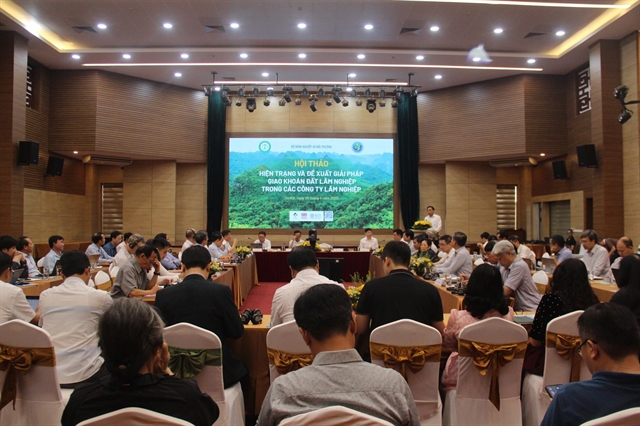 Environment
Environment

 |
| Seminar “Current Status and Proposed Solutions for Forestry Land Contracting in Forestry Companies” in Hà Nội on Friday reviewed and proposed solutions to enhance effectiveness of policy of allocating forestry land to contractors. VNS Photo Tố Như |
HÀ NỘI – The policy of allocating forestry land to contractors through forestry companies in Việt Nam has achieved significant success in forest protection and development, as well as improving local livelihoods.
However, shortcomings in practice demand a comprehensive approach, from institutional reform and enhanced management to greater flexibility in the contracting mechanism.
These findings were presented at the seminar “Current Status and Proposed Solutions for Forestry Land Contracting in Forestry Companies”, co-hosted by the Ministry of Agriculture and Environment and the Việt Nam Association of Agricultural Economics and Rural Development Sciences on Friday in Hà Nội.
Several proposals were discussed at the seminar to refine the land contracting policy, aiming for sustainable development in Việt Nam’s forestry sector.
According to Deputy Minister of Agriculture and Environment Nguyễn Quốc Trị, over the past 30 years, forestry companies nation-wide have allocated 458,000ha of land, accounting for 27 per cent of the total managed forestry land.
The policy has led to positive changes, mobilising social resources effectively, especially from local residents, forestry companies, and forest management boards, resulting in successful forest plantation models and agroforestry practices on contracted land, Trị told the seminar.
As a result, forest protection and land use efficiency have improved, contributing to socio-economic development and better living standards for local communities, he said.
Among the different forms of contracting, performance-based and production-step-based contracts where the company maintains control over operations, management, and forest protection have yielded better economic outcomes.
Most contractors are local residents with agricultural land and employment, helping alleviate poverty, stabilise settlement patterns, and maintain security and public order.
Nguyễn Văn Tiến, vice chairman of the Việt Nam Association of Agricultural Economics and Rural Development Sciences, said: “Through our survey of 37 contracting households across six provinces, most depend mainly on agriculture. Each household has an average of 4.65 members, 2.78 main labourers, of which 2.49 are agricultural workers.”
“Their average annual income is VNĐ167 million (US$6,550), with VNĐ53 million ($2,080) or 31.73 per cent coming from forest contracting, VNĐ87 million ($3,410) from agriculture, and VNĐ27 million ($1,060) from other sources,” Tiến said.
However, he pointed out several limitations in the implementation of the policy that existing regulations on eligible contractors, contract size, duration, as well as the rights and responsibilities of stakeholders are not fully aligned with practical realities.
These issues stem from poor policy communication, weak forest protection forces, incomplete land records, inadequate monitoring, and complicated land disputes.
Additionally, enforcement mechanisms remain insufficient, making contract management difficult.
He proposed making the policy framework more flexible. For land already allocated or leased to forestry companies, these entities should be allowed to conduct business activities in accordance with the law.
Regarding contracts, the State should issue general policy frameworks, but specific terms such as contract forms, agreement contents, stakeholder rights and obligations, profit-sharing mechanisms, and penalties should be negotiated between the companies and contracting households, in accordance with the Civil Code.
The regulations would help reduce practical discrepancies and enhance autonomy for all involved parties, he said.
Regarding exporting forest products, Tô Xuân Phúc, policy analyst of Forest Trends said that major export markets are becoming increasingly stringent regarding legal compliance and deforestation.
The EU Deforestation Regulation (EUDR), effective from early 2026, stipulates that wood, coffee, and rubber products grown on forestry land not compliant with Vietnamese Government regulations including contracting provisions may not meet EUDR criteria and could be rejected from the EU market.
Phúc also noted that it remains unclear whether agricultural products grown on forestry land particularly land managed by forestry companies will be permitted for export to the EU.
However, current land use issues highlight challenges in market access for these products in the future.
Another issue raised by Phúc is the immense potential of the forest carbon market in generating new revenue for forestry companies through carbon credits.
Implementing the master plan and applying future carbon standards could unlock forest carbon credit revenue to support forest protection and management by forestry companies.
However, to realise this potential, the country must first resolve issues in land use and contracting practices.
Việt Nam’s forestry sector is becoming more globally integrated, with growing market opportunities accompanied by significant challenges. Market access for agricultural and forestry products grown on contracted forest land, and the potential of carbon credit revenues, will only be attainable if the persistent shortcomings in land contracting are addressed comprehensively, he said. VNS




